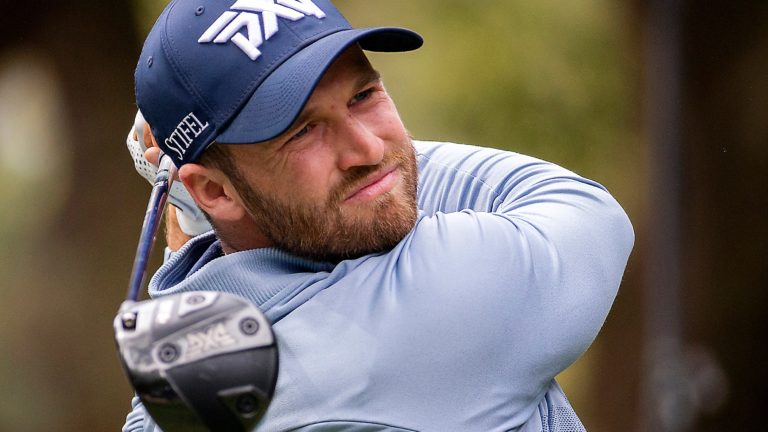

WESTERVILLE, Ohio (AP) — Wyndham Clark always knew where he wanted to go.
He just didn’t know where he was.
Clark made his first trip to Ohio for U.S. Open qualifying when he was 17 and had just finished his junior year of high school in Colorado. He said that wasn’t even the first time he tried to get into the U.S. Open. But when Clark saw that Columbus offered more spots than any of the other qualifying sites, he liked his odds.
Only when he arrived did he realize why the field was so big.
He saw Vijay Singh. Also at The Lakes and Brookside that year was David Duval. The name on another bag said Charles Howell III.
“I didn’t realize it was the tour stop the first time I came,” Clark said. “I was walking around seeing a bunch of pros and I was like, ‘Holy cow!’ I was 17. I was awestruck.”
Imagine the feeling he had Monday night.
The cold beer in his hand and the soft grin gave Clark away. After more than a decade of trying and failing, the 27-year-old is finally going to the U.S. Open.
“I really want to smile,” Clark said, “but I’m too exhausted.”
These are the stories that play out across the country, and it’s what sets the U.S. Open apart from the other majors.
The British Open also is open, but access now is largely restricted to “qualifying events” that are part of professional tours and events. The U.S. Open, still not back to normal because of COVID-19 travel restrictions, offered 66 of its 156 spots to players who made it through 36 holes of qualifying. In normal years, half of the field has to qualify.
Clark was among 9,069 players who signed up for the U.S. Open and paid a $200 fee. Some of them probably had no chance to get past the first stage of 18-hole qualifying. For some of them, simply having the chance was all that mattered.
Nineteen players had to go through 18-hole and 36-hole qualifying to get into the U.S. Open. One of them was Carson Schaake, four years removed from the University of Iowa and relegated to mini-tours.
He won his local qualifier in Nebraska. On Monday, he was medalist at the other Ohio qualifier against a 55-man field that featured 12 players who have won on the PGA Tour. Schaake has never played a PGA Tour event. His first one will be the U.S. Open.
Clark is in his third year on the PGA Tour and lost in a playoff last fall to Brian Gay in the Bermuda Championship. He is capable of winning next week at Torrey Pines.
But he used to be one of those dreamers.
Clark was still in elementary school, already hooked on golf, when in consecutive years, a pair of 16-year-olds in Colorado made it to the U.S. Open — Derek Tolan in 2002 at Bethpage Black and Tom Glissmeyer in 2003 at Olympia Fields. That was all the motivation he needed.
“I looked up to them as a Colorado kid,” Clark said.
The youngest qualifier was Andy Zhang, who was 14 when he played at Olympic Club in 2012. Then there’s Jeff Brehaut, who was 44 when he made his U.S. Open debut in 2007 at Oakmont.
Clark falls somewhere in between.
He said he has been trying since he was 15, and he guesses he has reached the final stage about a half-dozen times. Clark had little reason to believe this would be the year.
He missed the cut last week at the Memorial. It was his eighth consecutive week playing, and he was fried even during a three-hour rain delay Monday that forced him to finish in near darkness. Playing the tougher Brookside course first, he opened with a 64.
Then, it was a matter of hanging on. That’s the hardest way to play golf, and he was feeling it. Trying to protect a score instead of chasing one made the fairways at The Lakes look a lot more narrow than they really were.
“When you have to put the pedal to the metal, you’re going,” he said. “When you feel like you’re holding on, trying not to give away shots, that was hard. I made a lot of tentative swings. We ended up taking less club so I could hit full shots and make better swings.”
It paid off. He shot 70 to make it with four shots to spare.
Next up is a break, maybe the rest of the week without touching his clubs, before going to San Diego over the weekend to prepare for a major he only dreamed about playing.
Did he dream about winning? As a teenager, no.
“It was more about getting there,” he said. “When I was in high school, winning for me was just getting there. Just that I was there, being on TV, having that accolade, playing the Open with my peers, that would have been the win.”
It’s different now. Clark has played the PGA Championship twice, and he is No. 60 in the FedEx Cup on the PGA Tour. He now feels he’s supposed to be at the U.S. Open, no matter how long it took for him to get there.
___
More AP golf: https://apnews.com/hub/golf and https://twitter.com/AP_Sports